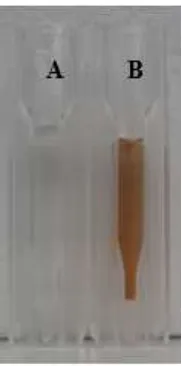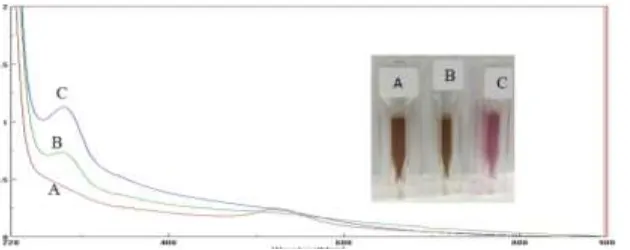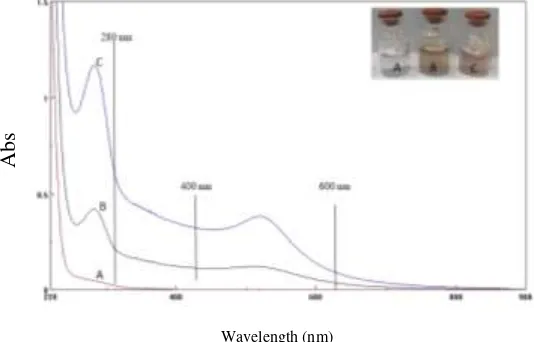214
pH Effect of Gold Nanoparticles Synthesis Encapsulation
in Polyamide Amine Generation 3.0
(AuNP-PAMAM G3.0)
Pujiyanto Anung1*, Lestari Enny1, Kurniasih Dede1, Mujinah1, Sholikhah Umi Nur1, Gunawan Adang Hardi1, Amalia Sarah S.2 and Mutalib Abdul3
1. Center for Radioisotopes and Radiopharmaceuticals Technology, National Nuclear Energy Agency, PUSPIPTEK Area, Building 11, South Tangerang, Banten,15310, INDONESIA
2. Department of Chemistry, Faculty of Mathematics and Natural Sciences, University of Indonesia, INDONESIA 3. Department of Chemistry, Faculty of Mathematics and Natural Sciences, Padjajaran University, INDONESIA
*antoapu@gmail.com
Abstract
The unique properties of gold nanoparticles (AuNP)
allow them to be used as drug and gene delivery agent,
so they are effective in diagnosis and therapy. At the
moment, one of AuNP development is AuNP
encapsulated polyamide amine third generation
(PAMAM G 3.0). The synthesis of
AuNP-PAMAM G 3.0 can be done by reacting HAuCl
4with
PAMAM G3.0, then adding NaBH
4as a reducing agent.
This makes AuNP-PAMAM G 3.0 to be strongly
influenced by the pH reaction.
The results of this study show that AuNP has sizes
ranging from 11 to 19 nm at pH 2 while their sizes are
2 to 5 nm at pH 7 and 9. The separation using Sephadex
PD-10 column shows that the elution efficiencies are
10% at pH 2, 40% at pH 7 and 50% at pH 9. Gold
nanoparticles at pH 7 and 9 are more stable than pH 2
in saline. Based on the above results, it is shown that
AuNP could be encapsulated by PAMAM G3.0 at pH 7
and 9 but AuNP at pH 2 could not.
Keywords: Gold Nanoparticle (AuNP), PAMAM G3.0, pH, encapsulation.
Introduction
Gold nanoparticles (AuNPs) have unique properties that may be applicable to drug delivery agents or gene delivery agents1. The unique properties of AuNPs are their optical and electronic characteristics which are influenced by AuNP sizes, so they can be used in therapeutic and bioimaging fields2-4. The AuNP manufacturing is done by reducing [AuCl4-] ions with a reductant and added stabilizer to maintain their stability. The development of AuNP as a therapy and drug delivery agent still needs an innovation from several proceeding or supporting studies. Previous studies indicated that AuNP encapsulation in PAMAM has been widely developed to improve the AuNP’s ability5-7. In the said studies, they were using raw materials from HAuCl4 or NaAuCl4 which are readily available in the market. The AuNP encapsulated PAMAM research in Indonesia has been developed from gold metal (Au Foil) converted into HAuCl4 which is reacted with PAMAM G3 and G48-10.
The pH influence in AuNP encapsulated PAMAM synthesis however, has not been observed. The pH effect study is important because PAMAM dendrimers are branched polymer and composed of tertiary amine groups in which the stability is controlled by pH11. The stability could pose an effect on the PAMAM's ability to encapsulate the gold nanoparticles (AuNP). The research that proves the pH effect on the AuNP encapsulated PAMAM dendrimer G3.0 synthesis is still limited. Therefore, we will investigate the pH effect on AuNP encapsulated PAMAM by UV-Vis Spectrophotometer, stability in saline solution and separation using Sephadex column PD-10.
Material and Methods
Materials: Polyamidoamine or PAMAM dendsrimers, Ethylene diamine (EDA) core group, Amine surface 3th generation (G3.0) in the form of 10% solution in methanol were purchased from Sigma-Aldrich while Au foil (gold purchased from Merck. Water and saline were obtained from IPHA. Whatmann Paper no. 1, inner and outer capsules were from local supply. Sephadex PD-10 column was from GE Healthcare. The beaker glass and Erlenmeyer were obtained from Pyrex, while adjustable micropipettes were produced by Eppendorf. Glass chamber and syringe were purchased by local supplier.
The instruments used in this study were analytical scales (Kern), hotplate magnetic stirrer (Cimarec), radioactivity enumerator (Gammatec II) and Gamma Ionization Chamber (Atomlab Plus) and Spectrophotometer UV/Vis (Jasco32 V-550) and Transmission Electron Microscopy (TEM JEOL JEM 1400 at Chemistry Department, Faculty of Mathematics and Natural Sciences, Gadjah Mada University.
Methods
215 facility to be irradiated at the rabbit system during a controlled time interval (recorded).
Preparation of HAuCl4 from Au foil: In addition, treatment involves the dissolving process of the Au-natural metal using aqua regia to obtain AuCl4-. Gold metals are dissolved in 5 mL of aqua regia (HCl: HNO3) and heated until the solution was evaporated. Then, it is dissolved in 10 mL of aquabidest and the solvent is evaporated. The washing process was done for 3 times. Finally, HAuCl4 was dissolved using aquabidest, so that the concentration of HAuCl4 solution is obtained. The activity of dissolution results was measured using spectrophotometer UV-Vis and Transmission Electron Microscopy (TEM).
Preparation of H198AuCl
4 from Au foil (Post-Irradiation Processes): The post-irradiation treatment was done on target material to adjust the processing time since the target material was removed from the irradiation facility. This was also to eliminate possible short-lived radioactive derived from irradiated tube material or targeted material impurities. In addition, the post-irradiation treatment involves the dissolving process of the Au-natural metal using aquaregia to obtain 198AuCl
4-. Gold metals were dissolved using 5 mL of aqua regia (HCl: HNO3) and heated until the solution evaporated. Then, it was dissolved in 10 mL of aquabidest until the solvent was evaporated. The washing process was done for 3 times. Finally, the H198AuCl
4 was dissolved using aquabidest, so that the concentration of H198AuCl
4 solution is obtained. The activity of dissolution results was measured by Gamma Ionization Chamber and the absorbance using UV-Vis Spectrophotometer measurement.
Preparation of gold nanoparticles Au (AuNP) encapsulated PAMAM dendrimer G 3.0: Nanoparticles Au (AuNP) encapsulated PAMAM dendrimer G 3.0 were prepared by reacting PAMAM dendrimer G3.0 with HAuCl4 solution, then stirred for 30 minutes in the flask. NaBH4 0.2 M was added, then stirred for several hours. During the stirring process, the flask was wrapped using aluminium foil. The final pH was measured. In order to encapsulate AuNP with PAMAM Dendrimer G 3.0, the result was investigated with UV-Vis Spectrophotometer at ambient temperature.
Preparation of gold nanoparticles marked 198Au (198AuNP) encapsulated PAMAM dendrimer G 3.0: 198Au (198AuNP) encapsulated PAMAM dendrimer G 3.0 was prepared by the same method followed by purification. The impurities of 198AuNP PAMAM dendrimer G 3.0 were removed using Sephadex PD-10 columns. The characterization was done by UV-Vis Spectrophotometer, Thin Layer Chromatography (TLC) and gamma counter. This method was repeated using HAuCl4 solution at pH 2 and 7.
Gold Nanoparticles PAMAM G 3.0 (AuNP PAMAM G 3.0) Stability in Saline: 0.5 mL AuNP PAMAM G 3.0 pH 2, 7 and 9 solutions were diluted in 1 mL saline. The
solutions were stored in an incubator at 37oC for 7 days. The stability was then measured using UV-Vis adding the NaBH4 solution, the color changed from clear to brownish yellow as shown in figure 1 B. This change occurred due to the reduction process of AuCl4- into gold nanoparticles (AuNP) with a charge of 3+ to 0.
Figure 1: A. Mixed solution of HAuCl4 and PAMAM G3.0, B. Mixed solution of HAuCl4 and PAMAM G3
after adding sodium borohydride (NaBH4)
The change was supported by the results of the spectrophotometry measurements at figure 2. The HAuCl4 solution provided maximum absorbance at about 300 nm. This suggests a transition of transfer of the electron shell d8 due to the presence of 4Cl- ions as the ligand surrounds the Au3+ ions to form complex compounds [AuCl
4]-. This transition process was commonly called ligand-to-metal-charge-transfer (LMCT) by chloride ions (Cl-) to Au3+ ions.
Based on the UV / Vis spectrum of AuNP-PAMAM G3.0 shown, there was a maximum absorption at about 280 nm12. This phenomenon indicates that the AuNP belonged to the PAMAM G3.0 cavity so that AuNP is encapsulated in PAMAM G3.0. The presence of an absorption increasing in the range 400 to 600 nm shows surface plasmon resonance due to the AuNP formation from the reduction process [AuCl4]- to AuNP by NaBH4. The above process shows that PAMAM generation 3.0 can be used as a template to control AuNP growth, so that AuNP nanoparticles would be encapsulated in PAMAM dendrimer G3.0.
216 amine group resulted from the electrostatic force that affected the stability of the amine group during pH change. Figure 3 shows the UV-Vis spectrum and the color of AuNP-PAMAM G3.0 at pH 2, 7 and 9. Both AuNP-AuNP-PAMAM G3.0 at pH 9 and 7 have similar UV-Vis spectrum and color. The maximum absorbance at about 280 nm was AuNP encapsulated in PAMAM dendrimers G3.0 characteristic.
The presence of absorbance at around 400 to 600 nm was indicating the surface plasmon resonance properties of AuNP encapsulated by PAMAM dendrimers G3.0. However, AuNP-PAMAM dendrimers G3.0 at pH 2 was not found when the maximum uptake was at about 280 nm wavelengths. There was a maximum absorption at 520 nm which showed the surface plasmon resonance properties of AuNP that were not encapsulated by PAMAM dendrimers G3.0. Differences in UV-Vis spectrum forms could be attributed to pH 9 and 7 which are more stable because tertiary amine properties bind the [AuCl4]- group and eventually form the gold nanoparticles (AuNP) encapsulated PAMAM G3.0.
After the addition of NaBH4, there is no repulsive in the positive charge force rejecting between the amine structure on the PAMAM surface with the tertiary amine structure inside the PAMAM so it facilitated the AuNP insert into PAMAM G3 cavity. At pH 2, the natural characteristic of tertiary amines on PAMAM was less stable or has weak base properties. Unbinding [AuCl4]- ion in PAMAM dendrimers restrained the AuNP from entering into the PAMAM G3.0 cavity. PAMAM G 3.0 only served as stabilizer at pH 2.
The differences were also supported by the different color of AuNP-PAMAM solution G3.0 at pH 9, 7 and 2 where the color of AuNP-PAMAM solution G3.0 pH 9 and 7 is brownish. It is identical to the size of the small AuNP nanoparticles. The pink color of the AuNP PAMAM dendrimers G3.0 at pH 2 indicates the larger size of nanoparticles. The morphological measurements of the encapsulated and unencapsulated AuNP using TEM are
shown in figure 4. The TEM results show that AuNP at pH 2 has sizes ranging from 11 to 19 nm while AuNP at pH 7 and 9 has sizes ranging from 2 to 5 nm.
Theencapsulation result shows that Au Nanoparticles at pH 2 are unencapsulated by PAMAM dendrimer, whereas Au nanoparticles at pH 7 and 9 can be encapsulated by PAMAM dendrimer as shown in figures 5-7. 198AuNP-PAMAM G3.0 was marked with radioisotopes. The 198Au at pH 9 and 7 shows the eligible efficiency elucidated from 198 AuNP-PAMAM G3.0 which was about 50% after being passed in Sephadex PD-10 columns. The columns at pH 7 and 9 showed clear color. It means that all AuNP passed. The 198AuNP-PAMAM G3.0 marked that radioisotope 198Au with pH 2 has an efficiency of below 10%. These results indicated that AuNP at pH 2 was not encapsulated in PAMAM G3.0 which caused precipitation in the Sephadex PD-10 column. The column colour became purple.
Based on figure 8, different pH of AuNP-PAMAM dendrimers G3.0 absorb radiation of different wavelengths. Indirectly, the absorption bands correspond to pH. The results of the UV-Vis spectrophotometer measurements at pH 2 indicated the absence of surface plasmon resonance properties at a wavelength of about 400 to 600 nm while at pH 7 and 9, they were present. All samples have an absorbance at about 280 nm which indicates that AuNP are still encapsulated in PAMAM dendrimers G 3.0.
The absence of surface plasmon resonance in AuNP-PAMAM G3.0 pH 2 was related to unstable AuNP because AuNP unencapsulated PAMAM G3. Its stability was disrupted by Na+ and Cl- ion causing AuNP precipitation. AuNP-PAMAM G3.0 at pH 7 and 9 stability was undisturbed by Na+ and Cl- ion because PAMAM G3.0 encapsulated AuNP well which serves as stabilizer. The above results show that AuNP-PAMAM G3.0 at pH 2 could not be used for therapy or diagnosis due to AuNP undergoing deposition.
217
Figure 3: Overlay of gold nanoparticles (AuNP) encapsulation in polyamide amine generation 3.0 (AuNP-PAMAM G3) UV-Vis spectrum at (A) pH 2, (B) 7 and (C) 9
Figure 4: Effect of pH on AuNP size encapsulated PAMAM dendrimer G 3.0
Figure 5: Efficiency of 198AuNP-PAMAM dendrimers G3.0 pH 9 after passed through the Sephadex PD-10 column
218
Figure 7: Efficiency of 198AuNP-PAMAM G3.0 pH 2 after passed through Sephadex PD-10 column
Figure 8: AuNP-PAMAM G3.0 stability at (A) pH 2, (B) 7 and (C) 9 in saline solution after being stored in an incubator at 37oC for 7 days
Conclusion
The pH of AuNP encapsulated PAMAM dendrimers G 3.0 was highly influenced in encapsulation process, size and stability. Based on TEM, it indicates that AuNP at pH 2 has sizes ranging from 11 to 19 nm which is larger than AuNP at pH 7 and 9 with sizes in the range of 2 - 5 nm. The separation result using Sephadex PD-10 column shows AuNP-PAMAM G3.0 at pH 7 and 9 has elution efficiency 40 to 50%, while AuNP-PAMAM G3.0 at pH 2 is below 10%. AuNP-PAMAM G3.0 PH 7 and 9 are more stable than AuNP-PAMAM G3.0 pH 2 in saline solution.
Acknowledgement
The authors would like to thank Mrs. Siti Darwati and Dr. Imam Kambali for their support and discussions. The authors gratefully acknowledge the Ministry of Technology and Higher Education.
References
1. Dreaden E.C., Austin L.A., Mackey M.A. and El-Sayed M.A., Size matters: gold nanoparticles in targeted cancer drug delivery,
Ther Deliv, 3(4), 457–478 (2012)
2. Cabral R.M. and Baptista P.V., The chemistry and biology of gold nanoparticle-mediated photothermal therapy: Promises and
challenges, Nano LIFE,3(3), 1330001-1 -18 (2013)
3. Jazayeri M.H., Amani H., Pourfatollah A.A., Pazoki-Toroudi H. and Sedighimoghaddam B., Various methods of gold nanoparticles
(GNPs) conjugation to antibodies, Sensing and Bio-Sensing
Research, 9, 17–22 (2016)
4. Bucharskaya A., Maslyakova G., Terentyuk G., Yakunin A., Avetisyan Y., Bibikova O., Tuchina E., Khlebtsov B., Khlebtsov N. and Tuchin V., Towards effective photothermal/photodynamic
treatment using plasmonic gold nanoparticles, Int. J. Mol. Sci.,
17(8),1-26 (2016)
5. Wang H., Zheng L., Guo R., Peng C., Shen M., Shi X. and Zhang G., Dendrimer-entrapped gold nanoparticles as potential
CT contrast agents for blood pool imaging, Nanoscale Research
Letters, 7(1), 190 (2012)
6. Kumari A., Singla R., Guliani A. and Yadav S.K.,
Nanoencapsulation for drug delivery, EXCLI Journal, 13, 265-286
(2014)
7. Garrido C., Simpson C.A., Dahl N.P., Bresee J., Whitehead D.C., Lindsey E.A., Harris T.L., Smith C.A., Carter C.J., Feldheim
A
bs
219 D.L. and Melander C., Gold nanoparticles to improve HIV drug
delivery, Future Medicinal Chemistry, 7(9), 1097-1107 (2015)
8. Ritawidya R., Pujiyanto A., Mujinah Witarti, Setiawan Ramli M., Kurniasih D., Yanuar A., Mutalib A. and Kardono L.B., Synthesis and characterization of poly(amidoamine) dendrimers
encapsulated 198Au Nanoparticles, Atom Indonesia, 38(3), 118-126
(2012)
9. Figueroa E.R., Lin A.Y., Yan J., Luo L., Foster A.E. and Drezek R.A., Optimization of PAMAM-gold nanoparticle conjugation for
gene therapy, Biomaterials, 35(5), 1725–1734 (2014)
10. Mandal T., Dasgupta C. and Maiti P.K., Engineering gold
nanoparticle interaction by PAMAM dendrimer, J. Phys. Chem. C,
117(26), 13627–13636 (2013)
11. Choudhary S., Gupta L., Rani S., Dave K. and Gupta U., Impact of dendrimers on solubility of hydrophobic drug molecules,
Review, Frontiers in Pharmacology, 8(261), 1-23 (2017)
12. Zhang X., Shen J., Ma H., Jiang Y., Huang C., Han E., Yao B. and He Y., Optimized dendrimer-encapsulated gold nanoparticles and enhanced carbon nanotube nanoprobes for amplified
electrochemical immunoassay of E. coli in dairy product based on
enzymatically induced deposition of polyaniline, Biosensors and

![Figure 2: Overlay of the UV-Vis Spectrum: A. Gold nanoparticles (AuNP) encapsulation in polyamide amine (PAMAM) dendrimer generation 3.0 [AuNP-PAMAM G3] and B](https://thumb-ap.123doks.com/thumbv2/123dok/4037602.1981022/3.595.97.504.558.743/figure-overlay-spectrum-nanoparticles-encapsulation-polyamide-dendrimer-generation.webp)

